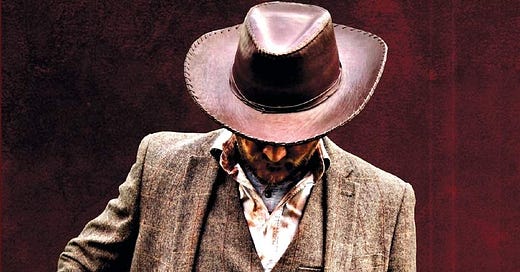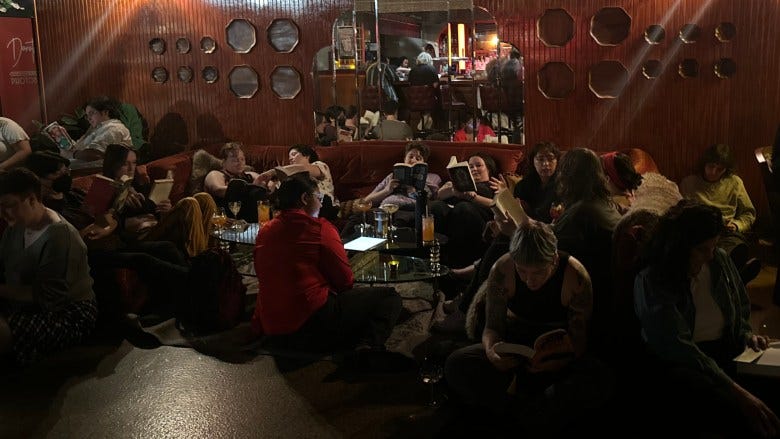Shoot first. Ask questions later.
This trope pre-dates Clint Eastwood. Gunslingers abound in American fiction—from the dime novels of the 1880s to Hollywood myths projected on silver screens. Vigilantes, in the Westerns, could be hotheaded townsfolk preparing to administer street justice on some transgressor. Or the protagonist might be a gunfighter aiming to right some wrong that the law had failed to address.
Vigilantism—lawless violence—is an American tradition. Frontier mythology, gun fetishism, and radical individualism have all been justified in one way or another. Those chickens are now roosting among us.
Today’s essay revisits Who Shot Liberty Valance? and It’s Complicated (originally published in February 2022).
The Western narrative expressed significant themes in American political development. Despite a professed universal reverence for The Constitution and The Founding Fathers, American culture is ambivalent concerning the rule of law. Many classic Westerns, such as Shane or The Man Who Shot Liberty Valance, highlight the tension between law . . . and disorder. Since director John Ford’s “Liberty Valance” was one of my Dad’s favorite movies, let’s use it as an example.
Justice was served when Tom Doniphon (John Wayne) shot Liberty Valance (Lee Marvin), an outlaw who had been terrorizing the frontier town of Shinbone. But Ranse Stoddard (Jimmy Stewart), the tenderfoot lawyer from back East, was credited with Valance’s demise. Doniphon was in the shadows when Liberty pulled on Rance, so onlookers thought it was Ranse’s shot that took him down. Stoddard’s reputation grew due to the shoot-out—providing him with a springboard into national politics. This was the irony: Ranse Stoddard, devoted to the law, advanced his career based on violence and a lie. Tom Doniphon, indifferent to the law, saved Ranse’s life and restored order in Shinbone with his revolver. Stoddard married Doniphon’s sweetheart and went to Washington. Doniphon drank himself to death.
At the film’s conclusion, an aging Senator Stoddard returns to Shinbone for Tom Doniphon’s funeral. A local reporter corners him and asks, “What brings you back to Shinbone, Senator?” For the first time, Ranse reveals the truth about who shot Liberty Valance. At the end of the interview, the reporter tears up his notes. Ranse asks him why he doesn’t want to publish the story. The journalist replies:
This is the West, sir. When the legend becomes fact, print the legend.
What’s the moral of the story? Some possibilities:
The law is not dependable.
Guns are more valuable than law books.
Legends are more persuasive than facts.
These propositions resonate today. They express the tension between two orders: the legal order and the social order. Self-government (democracy) is a bargain: citizens cede the right to engage in violence (for the redress of grievances) to the state which guarantees collective safety. The state creates an authoritative legal structure consisting of laws and enforcement mechanisms. Vigilantism violates the legal structure and therefore, the authority of the state. However, as shown in the film, when local authorities fail to maintain civil peace, social order is disturbed. The man who shot Liberty Valance was a hero because he removed the source of disorder threatening the town. Under these circumstances, vigilantism may be accepted—even lauded—by society. But both developments—outlaws who disturb the peace and corrupt authorities who fail to maintain order—undermine commitment to democratic self-governance.
You can see where this is going.
Vigilantism snags social, political, and cultural strands. But it is the tense intertwining of competing national ideas that draws all the threads into a single skein.
Dr. Alan Bean, a social justice advocate, writes:
America is a nation with two foundational dreams. There is the Manifest Destiny dream of steadily expanding white hegemony, and there is the Nation of Immigrants and Opportunity dream of radical inclusion. From the beginning, these two conflicting narratives have been fighting for the upper hand. The Civil War was simply the most bloody encounter in an ongoing war.
America’s founding documents provided competing models for the political community. Whereas the U.S. Constitution sliced and diced the jurisdictions of power so that property (including enslaved human beings) would be protected by law, the Declaration of Independence set forth the principle of equality and each person’s inalienable right to pursue happiness. Consequently, there are two American dreams: one exclusive, and one inclusive.
Both visions are rooted in American history. Tensions arise when political opponents draw on different foundational documents—the 1776 Declaration of Independence or the 1789 US Constitution. Historical facts are then gathered to support an exclusionary or inclusionary vision. Conflicts occur when factions mobilize to pursue their version of the American dream and suppress the alternative.
The history of the American republic is replete with vigilante activity. As the United States expanded its territorial reach in the 1800s, the Manifest Destiny narrative justified the extermination of native peoples (the “Trail of Tears”) and the expansion of white settlements westward. Before the Civil War, “Bloody Kansas” was the battleground of settler conflict over allowing slavery into the soon-to-be state. After the Civil War, there were three waves of Ku Klux Klan mobilization: (1) a movement to re-establish black peonage following Reconstruction, (2) the national Klan of the 1920s directing violence against Blacks, Catholics (Irish and Italians), and Jews (Polish and Russian), and (3) the anti-civil rights Klan of the 1950s and 1960s. Generally, the Manifest Destiny idea incited racist and revanchist vigilantism in rural areas and frontier regions. However, the exclusionary underpinning of that national idea also fueled intergroup conflict in the industrializing northeast. Intense extra-judicial violence in the North was directed against immigrants and Black migrants from the South. Its purpose was to secure the property rights of native-born “whites” in the cities. In 1920, this category certainly did not include Jews, or immigrants from Italy, Ireland, or Eastern Europe.
Between 1767 and 1910, three hundred twenty-six organized vigilante movements were responsible for (at least) 729 murders. Additionally, 5,459 killings by unorganized lynch mobs from 1882-1951 have been documented. Historian Richard Maxwell Brown notes that while proclaiming a reverence for “law and order,” Americans exhibit a remarkable degree of lawlessness in practice.
The Declaration’s vision of equality and opportunity motivated the social movements of the 20th century and beyond. Women’s suffrage, the civil rights movement, LGBTQ activism, BLM—all these mobilizations confronted a status quo that had excluded them from full citizenship. Challengers mostly worked within the law and dared the country to live up to its ideas. That’s why their marches, non-violent protests, petitions, and street theater took place in public. The overarching cause was to expand democracy. And by 1980, this vision had seemed generally accepted as the American dream.
We are now living in a period of reaction and backlash. Much of the rightist mobilization occurs out of public view, even when the militantly aggrieved take to the streets. Ethno-nationalist reactionaries seek to curtail demographic and cultural change by exacerbating division and fomenting chaos.
American historians aren’t surprised to see a new wave of violent revanchism by “citizens militias,” insurrectionists, and reactionary politicians. Why are we?
And now, your moment of . . . pure pleasure.
Writing—and reading—about serious subjects can be fairly depressing. Grounded will conclude each week with a lighter story so that you may leave with a bit of joy in your heart.
Silent Book Club is a global community of readers and introverts, with more than 500 chapters in 50 countries around the world led by local volunteers. SBC members gather in public at bars, cafes, bookstores, libraries, and online to read together in quiet camaraderie. Find a chapter near you.
Dorothy’s lowers the music and brightens the lights for Silent Book Club, the second Sunday of the month.
Keep scrolling down (below Notes) to reach the comments, share, and like buttons.
Dear Readers, could you please hit the “like” button? It helps improve the visibility of Grounded in search results. Thanks.
Follow me on social media:
Post.News Bluesky CounterSocial Facebook
Notes:
There are three versions of the Liberty Valance tale. They are all worth your time.
The original short story by Dorothy M. Johnson, “THE MAN WHO SHOT LIBERTY VALANCE.” Hearst’s International Combined with Cosmopolitan 127.1 (1949): 56–. Print. You’d have to get this from your local library or through Interlibrary Loan. Johnson’s Ranse character is much less sympathetic than the Jimmy Stewart/John Ford version.
The 1962 Film directed by John Ford (summarized in my post above). Amazon Prime Streaming.* DVD.*
Theatrical adaptation by Jethro Compton, produced at the Park Theatre, London, in 2014. Purchase a copy of the script here.*
References:
Frankie Bailey, Getting Justice: Real Life Vigilantism and Vigilantism in Popular Films.
Alan Bean, The American Vigilante Myth.
Richard Maxwell Brown, The History of Vigilantism in America. Ch. 5 of H. J. Rosenbaum and P. C. Sederberg, Vigilante Politics. ISBN: 978-0812276947
Noel Ignatiev, How the Irish Became White. Paperback.* Kindle.*
Dahlia Lithwick, The Vigilante Next Door.
Heather Cox Richardson, Letters from an American, February 12, 2022.
Sam Tanenhaus, Jan.6 wasn’t an insurrection. It was vigilantism. And more is coming.
*Amazon Associate link to purchase this product. I receive a referral fee.






